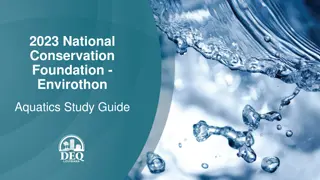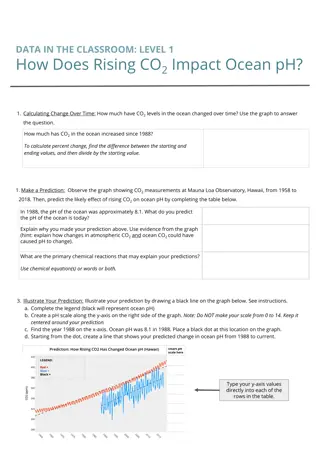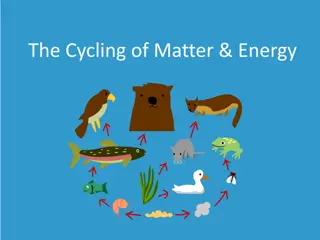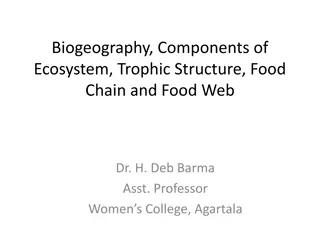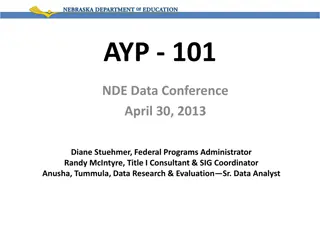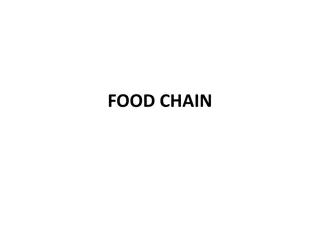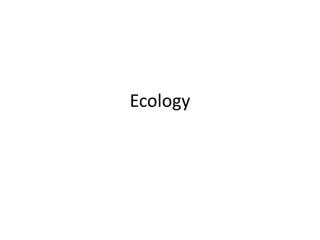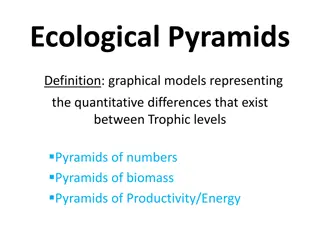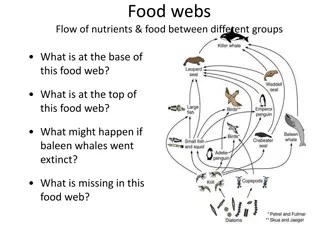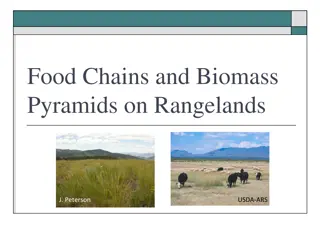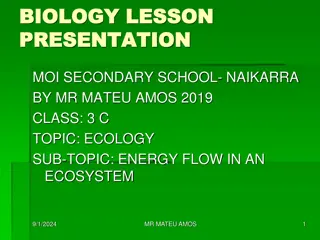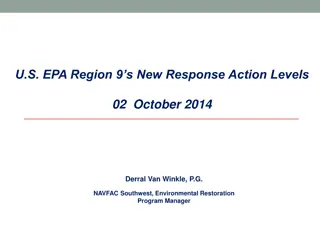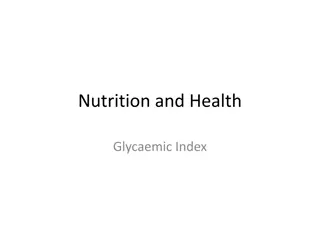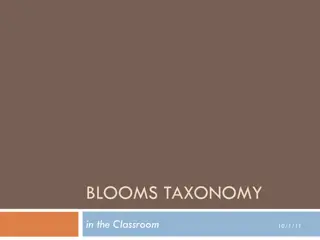Understanding Manufacturing Readiness Levels (MRLs) in Defense Technology
Manufacturing Readiness Levels (MRLs) are a vital tool in assessing the manufacturing maturity and associated risks of technology and products in defense acquisitions. They provide decision-makers with a common understanding of the maturity levels to support informed decisions throughout the acquisi
1 views • 12 slides
Understanding Special Monthly Compensation (SMC) Levels and Benefits
Special Monthly Compensation (SMC) offers various levels of benefits based on the extent of service-related disabilities, such as anatomical losses, blindness, and aid and attendance needs. Veterans may receive different SMC levels like SMC-K, L, M, N, and O depending on the severity and combination
1 views • 42 slides
Dissolved Oxygen Measurements and Factors Affecting Oxygen Levels
Understanding the importance of dissolved oxygen in water is crucial for the survival of aquatic plants and animals. Factors such as chemical reactions, temperature, pressure, and light penetration influence oxygen levels. The Winkler method is commonly used for dissolved oxygen measurements. This m
4 views • 11 slides
2023 National Conservation Foundation - Envirothon
Explore the intricate dynamics of aquatic ecosystems and wetlands conservation through this comprehensive study guide. Discover the importance of watersheds, the hydrologic cycle, aquatic food webs, energy flow at trophic levels, and common macroinvertebrates in Louisiana. Learn about different wetl
3 views • 27 slides
Case Study: Managing High HbA1c and Normal Fasting Glucose Levels
A case study discusses a 69-year-old woman with a history of stable diabetes facing elevated HbA1c levels despite normal fasting glucose. Initial investigations, including a day curve test, reveal high postprandial glucose levels. The analysis leads to identifying iron deficiency anemia, prompting f
9 views • 22 slides
Environmental Math and Efficiency Analysis
Explore environmental math problems related to forest loss, uranium energy conversion, and energy transfer through trophic levels. Dive into calculations involving forested hectares, converting uranium into fluorescent light, and energy efficiency at different trophic levels.
1 views • 33 slides
Understanding Ocean pH Changes Due to Rising CO2 Levels
Explore the impact of rising CO2 levels on ocean pH through data analysis, predictions, and comparisons. Learn how to calculate changes over time, predict pH levels, and understand the processes influencing ocean acidification at different locations. Dive into levels ranging from measuring changes i
1 views • 6 slides
Understanding the Cycling of Matter and Energy in Ecosystems
Explore the interconnected web of life within biomes and ecosystems, where organisms play vital roles in maintaining balance. Learn about producers, consumers, and decomposers, and how energy flows through different trophic levels. Dive into the world of primary, secondary, and tertiary consumers, a
0 views • 24 slides
Impacts of Shark Removal on Coral Reef Dynamics
This study delves into the repercussions of shark removal on the intricate ecosystem of coral reefs. It explores the correlation between shark abundance, reef fish community structure, benthic disturbances like cyclones and bleaching, and the synergistic effects of top-down and bottom-up processes.
1 views • 18 slides
Understanding Biogeography, Ecosystem Components, Trophic Structure, Food Chain, and Food Web
Biogeography delves into the origin, distribution, and adaptations of plants and animals, aiding in earth surface differentiation. Ecosystems involve interactions between biotic and abiotic elements, forming trophic structures, biodiversity, and material cycles. Learn about the concepts, definitions
0 views • 29 slides
Understanding Force Protection and FPCON Levels in the US Military
Force Protection (FP) involves preventive measures in the US military to mitigate hostile actions. FPCON is a system to respond to terrorist threats against military facilities by determining security levels. FPCON levels vary from Normal to Delta based on the assessed threat level. The purpose of F
1 views • 13 slides
Managing Blood Sugar Levels at Home for Low/No Vision
Explore the importance of monitoring blood glucose levels at home for individuals with low/no vision, learn about talking blood glucose meters, and make continuous glucose monitors accessible. Understand why maintaining blood sugar levels is crucial to prevent complications in diabetes, and get tips
2 views • 25 slides
Hosting a Staff Briefing About T Levels
This slide deck, designed by the DfE T Levels Team, is a resource for schools/colleges conducting a staff briefing on T Levels. It aims to generate interest and positivity among staff about T Levels, providing a customizable presentation that can be delivered in 20-30 minutes. The deck includes note
1 views • 29 slides
Diagnostic Reference Levels in Medical Imaging and Radiation Protection
The concept of Diagnostic Reference Levels (DRLs) is crucial in evaluating the amount of ionizing radiation used in medical imaging procedures. DRLs help determine if radiation levels are appropriate and need optimization. Authorized bodies establish numerical DRL values as advisory guidelines. Loca
1 views • 26 slides
Understanding T Levels in Higher Education
T Levels are a new type of two-year technical education courses designed for 16-19 year-olds, focusing on a blend of classroom learning and industry experience to prepare students for skilled employment or further study. Developed in collaboration with employers, T Levels offer a more rigorous and s
1 views • 14 slides
Understanding Low Testosterone Levels and Treatment Options for Men
Testosterone is a vital steroid hormone that plays a key role in the development of male characteristics. Low testosterone levels can lead to various health effects, including decreased muscle mass, bone density, and libido. Testosterone replacement therapy (TRT) is commonly used to treat males with
0 views • 36 slides
Understanding Ecosystems: Structure, Components, and Functions
Ecosystems are intricate units where living organisms interact with each other and the environment. They consist of biotic (living) and abiotic (non-living) components, interrelated in a chain of interactions. Biotic components include autotrophs, heterotrophs, and decomposers, while abiotic compone
0 views • 15 slides
Understanding AYP in Education: Goals, Subgroups, and Performance Levels
AYP (Adequate Yearly Progress) is a measurement used in education to assess schools' performance in meeting academic standards. AYP is calculated at both building and district levels based on various subgroups such as race, income level, and English proficiency. This assessment includes recently arr
0 views • 57 slides
Exploring Trophic Levels and Energy Flow in Ecosystems
Understanding trophic levels and energy flow in ecosystems is vital for comprehending the intricate relationships between producers, consumers, and decomposers. Energy enters the food web through producers, transferring from one trophic level to another. Explore the dynamics of Mono Lake ecosystem a
0 views • 19 slides
Understanding Ecosystem Dynamics: The Food Web Explained
An ecosystem comprises various organisms living together in a community. Energy flow through food chains depicts how organisms obtain energy and nutrients from one another. Food chains show the sequence of feeding relationships, while a food web illustrates interconnected chains within a community.
1 views • 13 slides
Understanding Energy Flow in Ecosystems
Energy flow in ecosystems is vital for sustaining life as it moves through different trophic levels. Primary producers harness solar energy to create organic material, which is then consumed by herbivores, carnivores, and decomposers, forming intricate food chains. Terms like biomass, productivity,
0 views • 8 slides
Understanding Food Chains and Ecosystems in Nature
Explore the interdependence of living organisms in their environment through food chains, trophic levels, and the roles of producers, consumers, and decomposers. Learn how energy flows through ecosystems, the classification of animals based on feeding styles, and the vital role of decomposers in rec
0 views • 34 slides
Understanding the Intricacies of Food Chains in Ecosystems
Food chains play a crucial role in the transfer of energy within ecosystems. They consist of various trophic levels where organisms either consume or are consumed by others. Different types of food chains like grazing, detritus, predator, and parasitic chains interact to maintain the balance of ener
0 views • 15 slides
Understanding Ecology and Basic Concepts in Environmental Science
Explore the fundamental concepts of ecology and environmental science, including species, habitat, population, community, autotrophs, heterotrophs, environment components, food chains, and trophic levels. Learn about the intricate relationships between living organisms and their surroundings in this
0 views • 35 slides
Understanding Ecological Pyramids: Models of Trophic Relationships
Ecological pyramids are graphical models that depict quantitative differences between trophic levels in an ecosystem. They come in three types: Pyramids of Numbers, Pyramids of Biomass, and Pyramids of Productivity/Energy. Pyramids of Numbers show the number of organisms at each trophic level, Pyram
0 views • 4 slides
Understanding Food Webs and Trophic Levels in Ecosystems
Food webs illustrate the flow of nutrients and energy between different organisms in an ecosystem. At the base of a food web are the primary producers, while predators occupy the top. If baleen whales were to go extinct, it could disrupt the balance of their ecosystem. Biomass decreases as energy is
0 views • 11 slides
Understanding Food Chains, Trophic Levels, and Biomass Pyramids on Rangelands
Explore the intricate dynamics of food chains, trophic levels, and biomass pyramids on rangelands through informative visuals and explanations. Learn how energy flows through different levels, the concept of biomass pyramids, and the impact of vegetarianism on food chains and energy efficiency.
0 views • 11 slides
Exploring Energy Flow in Food Webs
Dive into the intricate relationships of organisms in various food chains and webs, understanding the flow of energy from producers to consumers and the impact of changes in population sizes. Discover the significance of trophic levels and the role of energy pyramids in ecosystems.
0 views • 9 slides
Understanding Animal Communities in Geography
Animal communities are formed by various species occupying the same habitat or microhabitat, interacting within a biological community. Each species has a unique ecological niche, influencing interactions like competition and predation. Communities consist of producers, herbivores, carnivores, and m
1 views • 9 slides
Understanding Energy Flow in Ecosystems: A Comprehensive Overview
Energy flow in an ecosystem involves the transfer of energy from producers to consumers through different trophic levels, with only a small fraction of energy being passed on at each level. This process is essential for sustaining life within an ecosystem, highlighting the interconnectedness of all
0 views • 11 slides
Understanding Energy Flow in Ecosystems: A Visual Guide
Explore the intricate dynamics of energy flow in ecosystems through a collection of visually engaging images depicting autotrophs, heterotrophs, food chains, ecological pyramids, and more. Dive into the concept of trophic levels, food webs, and feeding relationships, unraveling the journey of energy
0 views • 13 slides
Understanding Energy Flows and Matter Cycles in Living Systems
Interactions among living systems and their environment involve the movement of matter and energy. Energy flows through trophic levels, starting with primary producers like plants and autotrophs converting solar energy. It then progresses to primary consumers, secondary consumers, and tertiary consu
1 views • 15 slides
Exploring Ecosystem Dynamics: Food Chains, Energy Pyramids, and Trophic Levels
An exploration of key concepts in ecosystem dynamics, including food chains, energy pyramids, secondary consumers, and trophic levels. Discover the interconnected relationships between organisms in an ecosystem and the vital role of key species. Dive into the differences between food chains and food
0 views • 16 slides
Enhancing Ecological Sustainability through Gamified Machine Learning
Improving human-computer interactions with gamification can help understand ecological sustainability better by parameterizing complex models. Allometric Trophic Network models analyze energy flow and biomass dynamics, but face challenges in parameterization. The Convergence Game in World of Balance
0 views • 12 slides
Understanding Ecosystems: An In-depth Exploration
Delve into the fascinating world of ecosystems through this comprehensive guide, covering the definition, components, relationships, classifications, and key learnings. Explore the intricate balance between living and non-living elements, trophic relationships, food chains, and diverse ecosystem typ
0 views • 11 slides
Guidelines on EPA Region 9 Response Action Levels for TCE Contamination
EPA Region 9 has established response action levels for TCE contamination, with tiered concentrations for different exposure scenarios. The State of California provides guidance aligned with these levels. DTSC concurs with EPA's residential and industrial response levels but recommends consultation
0 views • 10 slides
Understanding Glycaemic Index in Nutrition and Health
Glycaemic Index (GI) measures how carbohydrate-containing foods affect blood glucose levels. High GI foods raise blood glucose rapidly, while low GI foods release glucose gradually. Studies track impacts on blood glucose levels, insulin secretion, fat storage, and pancreatic function. High GI foods
0 views • 15 slides
Understanding Blooms Taxonomy in Educational Settings
In the classroom, understanding Bloom's Taxonomy is essential for effective teaching and learning. This taxonomy, created by Benjamin Bloom, categorizes levels of thinking skills from basic memorization to higher-order critical thinking. The revised Bloom's Taxonomy emphasizes the importance of prog
0 views • 24 slides
Understanding S-100 Readiness Levels for Product Development
The concept of S-100 Readiness Levels, based on NASA's Technical Readiness Levels, is crucial for progressing ideas from research to regular product use. This framework, introduced by the International Hydrographic Organization, ensures a clear understanding of a specification's readiness for operat
0 views • 9 slides
Understanding Isolation Levels in Database Management Systems
Isolation levels in database management systems provide a way to balance performance and correctness by offering various levels of data isolation. These levels determine the degree to which transactions can interact with each other, addressing conflicts such as dirty reads, non-repeatable reads, and
0 views • 18 slides



